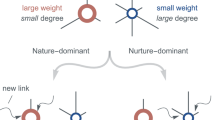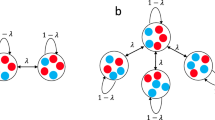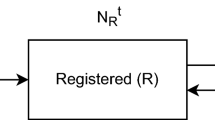Abstract
When studying human behaviour, it is important to understand not just how individuals interact, but also interactions at the level of communities and populations. Most previous modelling of networks has focused on interactions between individual agents. Here we provide a modelling framework to study the evolution of behaviour in connected populations, by regarding subpopulations as the basic unit of interaction and focusing on the population-level connection structure. We find that when the underlying game played by individuals is a potential game, utilizing such a structure greatly simplifies analysis. In addition, according to known general results on the convergence of evolution dynamics to Nash equilibria in a potential game, our formulation provides a tractable model on behavioural dynamics in social networks that needs only conventional techniques from evolutionary game theory.
This is a preview of subscription content, access via your institution
Access options
Access Nature and 54 other Nature Portfolio journals
Get Nature+, our best-value online-access subscription
$29.99 / 30 days
cancel any time
Subscribe to this journal
Receive 12 digital issues and online access to articles
$119.00 per year
only $9.92 per issue
Buy this article
- Purchase on Springer Link
- Instant access to full article PDF
Prices may be subject to local taxes which are calculated during checkout



Similar content being viewed by others
Data availability
The simulation results used to produce the figures in this paper and the Supplementary Discussion are available from https://github.com/zusaiEGT/ConnectedEvol.
Code availability
The MATLAB (R2017) code for this simulation is available from https://github.com/zusaiEGT/ConnectedEvol.
References
Jackson, M. O. Social and Economic Networks (Princeton Univ. Press, 2008).
Levin, S. A. Dispersion and population interactions. Am. Nat. 108, 207–288 (1974).
Levin, S. A. & Paine, R. Disturbance, patch formation, and community structure. Proc. Natl Acad. Sci. USA 71, 2744–2747 (1974).
Chesson, P. Coexistence of competitors in spatially and temporally varying environments: a look at the combined effects of different sorts of variability. Theor. Popul. Biol. 28, 263–287 (1985).
Tilman, D. Competition and biodiversity in spatially structured habitats. Ecology 75, 2–16 (1994).
Tainaka, K. & Itoh, Y. Patch dynamics based on Prisoner’s Dilemma game: superiority of golden rule. Ecol. Modell. 150, 295–307 (2002).
Hanski, I. & Gaggiotti, O. Ecology, Genetics, and Evolution of Metapopulations (Elsevier, 2004).
Hanski, I. & Gilpin, M. Metapopulation Biology: Ecology, Genetics, and Evolution (Academic Press, 1997).
Colizzaa, V. & Vespignani, A. Epidemic modeling in metapopulation systems with heterogeneous coupling pattern: theory and simulations. J. Theor. Biol. 251, 450–467 (2008).
Bauer, M. & Frey, E. Delayed adaptation in stochastic metapopulation models. EPL 122, 68002 (2018).
Bauer, M. & Frey, E. Delays in fitness adjustment can lead to coexistence of hierarchically interacting species. Phys. Rev. Lett. 121, 268101 (2018).
Bauer, M. & Frey, E. Multiple scales in metapopulations of public goods producers. Phys. Rev. E 97, 042307 (2018).
Nagatani, T., Tainaka, K. & Ichinose, G. Metapopulation model of rock–scissors–paper game with subpopulation-specific victory rates stabilized by heterogeneity. J. Theor. Biol. 458, 103–110 (2018).
Nagatani, T., Ichinose, G. & Tainaka, K. Epidemics of random walkers in metapopulation model for complete, cycle, and star graphs. J. Theor. Biol. 450, 66–75 (2018).
Nagatani, T., Ichinose, G. & Tainaka, K. Metapopulation model for rock–paper–scissors game: mutation affects paradoxical impacts. J. Theor. Biol. 450, 22–29 (2018).
Nagatani, T., Ichinose, G. & Tainaka, K. Heterogeneous network promotes species coexistence: metapopulation model for rock–paper–scissors game. Sci. Rep. 8, 7094 (2018).
Becker, F., Wienand, K., Lechner, M., Frey, E. & Jung, H. Interactions mediated by a public good transiently increase cooperativity in growing Pseudomonas putida metapopulations. Sci. Rep. 8, 4093 (2018).
Limdi, A., Pérez-Escudero, A., Li, A. & Gore, J. Asymmetric migration decreases stability but increases resilience in a heterogeneous metapopulation. Nat. Commun. 9, 2969 (2018).
Peaudecerf, F. J. et al. Microbial mutualism at a distance: the role of geometry in diffusive exchanges. Phys. Rev. E 97, 022411 (2018).
Tarnita, C. E., Antal, T., Ohtsuki, H. & Nowak, M. A. Evolutionary dynamics in set structured populations. Proc. Natl Acad. Sci. USA 106, 8601–8604 (2009).
Boyd, R. & Richerson, P. J. Voting with your feet: payoff biased migration and the evolution of group beneficial behavior. J. Theor. Biol. 257, 331–339 (2009).
Weidenholzer, S. Coordination games and local interactions: a survey of the game theoretic literature. Games 1, 551–585 (2010).
Bowles, S. & Gintis, H. The moral economy of communities: structured populations and the evolution of pro-social norms. Evol. Hum. Behav. 98, 3–25 (1998).
Débarre, F., Hauert, C. & Doebeli, M. Social evolution in structured populations. Nat. Commun. 5, 3409 (2014).
Lehmann, L. & Keller, L. The evolution of cooperation and altruism—a general framework and a classification of models. J. Evol. Biol. 19, 1365–1376 (2006).
Perc, M., Gómez-Gardeñes, J., Szolnoki, A., Floría, L. M. & Moreno, Y. Evolutionary dynamics of group interactions on structured populations: a review. J. R. Soc. Interface 10, 20120997 (2013).
Zusai, D. & Lu, F. Polarization and segregation through conformity pressure and voluntary migration: simulation analysis of co-evolutionary dynamics.Games 8, 51 (2017).
Rand, D. & Nowak, M. A. Human cooperation. Trends Cogn. Sci. 17, 413–425 (2013).
Alger, I. & Weibull, J. A generalization of Hamilton’s rule—love others how much? J. Theor. Biol. 299, 42–54 (2012).
Alger, I. & Weibull, J. Homo moralis—preference evolution under incomplete information and assortative matching. Econometrica 81, 2269–2302 (2013).
Alger, I. & Weibull, J. Evolution and Kantian morality. Games Econ. Behav. 98, 56–67 (2016).
Newton, J. The preferences of homo moralis are unstable under evolving assortativity. Int. J. Game Theory 46, 583–589 (2017).
Monderer, D. & Shapley, L. S. Potential games. Games Econ. Behav. 14, 124–143 (1996).
Sandholm, W. H. Potential games with continuous player sets. J. Econ. Theory 97, 81–108 (2001).
Sandholm, W. H. Population Games and Evolutionary Dynamics (MIT Press, 2010).
Bramoullé, Y., Kranton, R. & D’Amours, M. Strategic interaction and networks. Am. Econ. Rev. 104, 898–930 (2014).
Szabó, G. & Borsos, I. Evolutionary potential games on lattices. Phys. Rep. 624, 1–60 (2016).
Staudigl, M. Potential games in volatile environments. Games Econ. Behav. 72, 271–287 (2011).
Staudigl, M. Co-evolutionary dynamics and Bayesian interaction games. Int. J. Game Theory 42, 179–210 (2012).
Benaïm, M. & Weibull, J. W. Deterministic approximation of stochastic evolution in games. Econometrica 71, 873–903 (2003).
Benaïm, M., Hofbauer, J. & Sorin, S. Stochastic approximations and differential inclusions. SIAM J. Control Optim. 44, 328–348 (2005).
Roth, G. & Sandholm, W. H. Stochastic approximations with constant step size and differential inclusions. SIAM J. Control Optim. 51, 525–555 (2013).
Hofbauer, J. Stability for the Best Response Dynamics (Univ. Vienna, 1995).
Gilboa, I. & Matsui, A. Social stability and equilibrium. Econometrica 59, 859–867 (1991).
Smith, M. J. The stability of a dynamic model of traffic assignment: an application of a method of Lyapunov. Transport. Sci. 18, 245–252 (1984).
Schlag, K. H. Why imitate, and if so, how? A boundedly rational approach to multi-armed bandits. J. Econ. Theory 78, 130–156 (1998).
McPherson, M., Smith-Lovin, L. & Cook, J. M. Birds of a feather: homophily in social networks. Annu. Rev. Sociol. 27, 415–444 (2001).
Ruef, M., Aldrihc, H. E. & Carter, N. M. The structure of founding teams: homophily, strong ties, and isolation among U.S. entrepreneurs. Am. Sociol. Rev. 68, 195–222 (2003).
Morris, S. Contagion. Rev. Econ. Stud. 67, 57–78 (2000).
Currarini, S., Jackson, M. & Pin, P. An economic model of friendship: homophily, minorities, and segregation. Econometrica 77, 1003–1045 (2009).
Currarini, S., Jackson, M. O. & Pin, P. Identifying the roles of race-based choice and chance in high school friendship network formation. Proc. Natl Acad. Sci. USA 107, 4857–4861 (2010).
Golub, B. & Jackson, M. O. Naive learning in social networks and the wisdom of crowds. Am. Econ. J. Microecon. 2, 112–149 (2010).
Golub, B. & Jackson, M. O. Does homophily predict consensus times? Testing a model of network structure via a dynamic process. Rev. Netw. Econ. 11, 1–28 (2012).
Golub, B. & Jackson, M. O. How homophily affects the speed of learning and best response dynamics. Q. J. Econ. 127, 1287–1338 (2012).
Golub, B. & Jackson, M. O. Network structure and the speed of learning: measuring homophily based on its consequences. Ann. Econ. Stat. 107/108, 33–48 (2012).
Jackson, M. O. & López-Pintado, D. Diffusion and contagion in networks with heterogeneous agents and homophily. Netw. Sci. 1, 49–67 (2013).
Bramoulle, Y., Currarini, S., Jackson, M. O., Rogers, B. W. & Pin, P. Homophily and long-run integration in social networks. J. Econ. Theory 147, 1754–1786 (2012).
Bramoullé, Y. Anti-coordination and social interactions. Games Econ. Behav. 58, 30–49 (2007).
Farrell, J. & Saloner, G. Converters, compatibility, and the control of interfaces. J. Ind. Econ. 40, 9 (1992).
Matsuyama, K., Kiyotaki, N. & Matsui, A. Toward a theory of international currency. Rev. Econ. Stud. 60, 283–307 (1993).
Zusai, D. Gains in evolutionary dynamics: a unifying approach to dynamic stability of contractive games and ESS. Preprint at arXiv https://arxiv.org/abs/1805.04898 (2018).
Acknowledgements
The authors thank I. Obara, R. Sawa and the participants of presentations at the University of Tsukuba, Stony Brook International Conference on Game Theory, East Asian Game Theory Conference and Southern Economic Association annual meetings for helpful suggestions and comments. D.Z. is grateful to the University of Oregon for hospitality during part of this work. The funders had no role in study design, data collection and analysis, decision to publish or preparation of the manuscript.
Author information
Authors and Affiliations
Contributions
J.W. and D.Z. designed the framework of the research, contributed to the design and mathematical analysis of the examples, and jointly wrote the paper. J.W. contributed to surveying the literature and exploring the implications. D.Z. contributed to mathematical formulation of the general model, and wrote the MATLAB code.
Corresponding author
Ethics declarations
Competing interests
The authors declare no competing interests.
Additional information
Publisher’s note: Springer Nature remains neutral with regard to jurisdictional claims in published maps and institutional affiliations.
Supplementary information
Supplementary Information
Supplementary Methods, Supplementary Figures 1–4, and Supplementary References.
Rights and permissions
About this article
Cite this article
Wu, J., Zusai, D. A potential game approach to modelling evolution in a connected society. Nat Hum Behav 3, 604–610 (2019). https://doi.org/10.1038/s41562-019-0571-0
Received:
Accepted:
Published:
Issue Date:
DOI: https://doi.org/10.1038/s41562-019-0571-0
This article is cited by
-
Evolutionary dynamics in heterogeneous populations: a general framework for an arbitrary type distribution
International Journal of Game Theory (2023)
-
Evolutionary dynamics of higher-order interactions in social networks
Nature Human Behaviour (2021)



